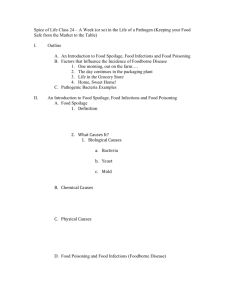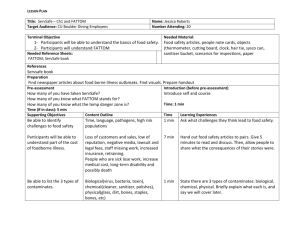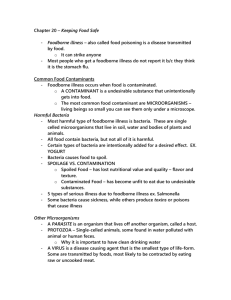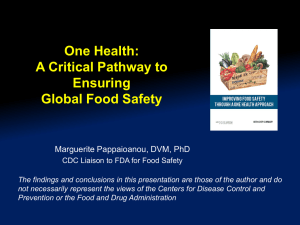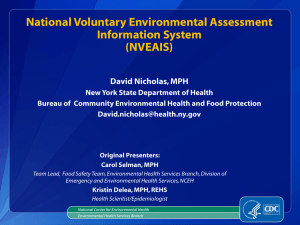Food Borne Illness Handout
advertisement
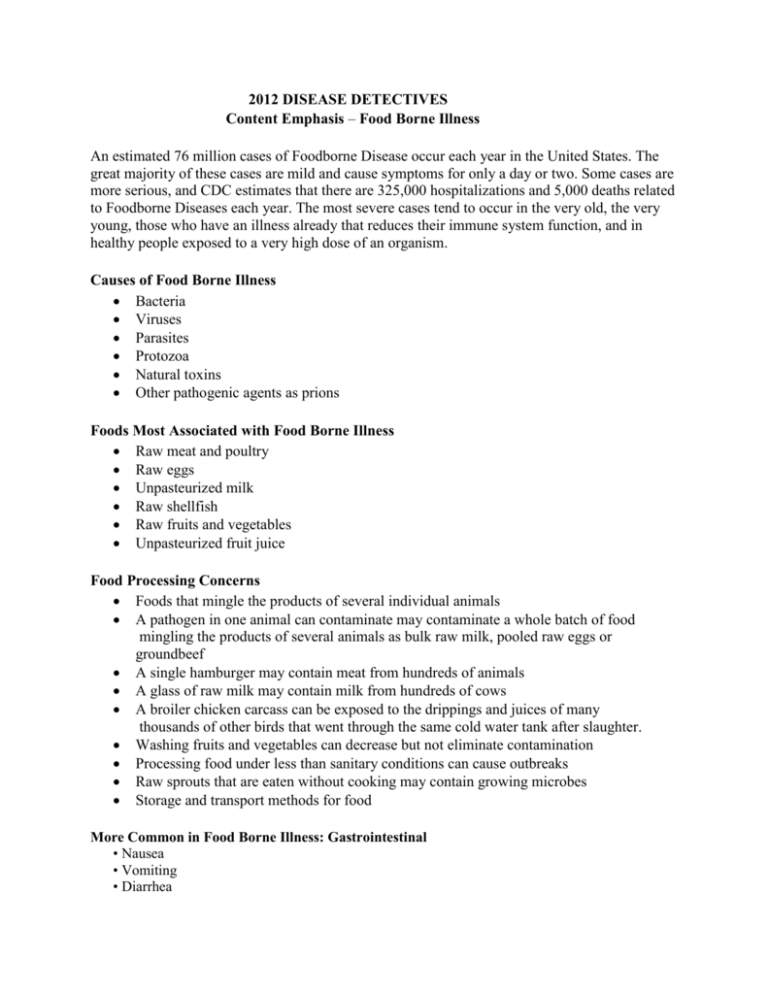
2012 DISEASE DETECTIVES Content Emphasis – Food Borne Illness An estimated 76 million cases of Foodborne Disease occur each year in the United States. The great majority of these cases are mild and cause symptoms for only a day or two. Some cases are more serious, and CDC estimates that there are 325,000 hospitalizations and 5,000 deaths related to Foodborne Diseases each year. The most severe cases tend to occur in the very old, the very young, those who have an illness already that reduces their immune system function, and in healthy people exposed to a very high dose of an organism. Causes of Food Borne Illness Bacteria Viruses Parasites Protozoa Natural toxins Other pathogenic agents as prions Foods Most Associated with Food Borne Illness Raw meat and poultry Raw eggs Unpasteurized milk Raw shellfish Raw fruits and vegetables Unpasteurized fruit juice Food Processing Concerns Foods that mingle the products of several individual animals A pathogen in one animal can contaminate may contaminate a whole batch of food mingling the products of several animals as bulk raw milk, pooled raw eggs or groundbeef A single hamburger may contain meat from hundreds of animals A glass of raw milk may contain milk from hundreds of cows A broiler chicken carcass can be exposed to the drippings and juices of many thousands of other birds that went through the same cold water tank after slaughter. Washing fruits and vegetables can decrease but not eliminate contamination Processing food under less than sanitary conditions can cause outbreaks Raw sprouts that are eaten without cooking may contain growing microbes Storage and transport methods for food More Common in Food Borne Illness: Gastrointestinal • Nausea • Vomiting • Diarrhea Cooking meat and poultry to USDA recommended safe minimum temperatures makes them safe to eat: • Beef, veal, lamb: steaks & roasts - 145°F • Beef, veal, lamb: ground - 160°F • Fish - 145°F • Egg dishes - 160°F • Pork - 160°F • Turkey, chicken & duck: whole, pieces & ground 165°F Reducing the Risk of Foodborne Illness Cook meat, poultry, and eggs thoroughly Separate – don’t cross-contaminate one food with another Chill – refrigerate leftovers promptly Clean – wash produce Report – suspected food borne illnesses to the local health department To avoid Microbial Foodborne Illness: Note: The Dietary Guidelines for Americans 2005 Clean hands, food contact surfaces, and fruits and vegetables. Meat and poultry should not be washed or rinsed. Separate raw, cooked, and ready-to-eat foods while shopping, preparing, or storing foods. Cook foods to a safe temperature to kill microorganisms. Chill (refrigerate) perishable food promptly and defrost foods properly. Avoid raw (unpasteurized) milk or any products made from unpasteurized milk, raw or partially cooked eggs or foods containing raw eggs, raw or undercooked meat and poultry, unpasteurized juices, and raw sprouts. The following information was obtained from the CDC’s frequently asked questions: 1. What are foodborne disease outbreaks and why do they occur? An outbreak of foodborne illness occurs when a group of people consume the same contaminated food and two or more of them come down with the same illness. It may be a group that ate a meal together somewhere, or it may be a group of people who do not know each other at all, but who all happened to buy and eat the same contaminated item from a grocery store or restaurant. For an outbreak to occur, something must have happened to contaminate a batch of food that was eaten by a the group of people. Often, a combination of events contributes to the outbreak. A contaminated food may be left out a room temperature for many hours, allowing the bacteria to multiply to high numbers, and then be insufficiently cooked to kill the bacteria. Many outbreaks are local in nature. They are recognized when a group of people realize that they all became ill after a common meal, and someone calls the local health department. This classic local outbreak might follow a catered meal at a reception, a pot-luck supper, or eating a meal at an understaffed restaurant on a particularly busy day. However, outbreaks are increasingly being recognized that are more widespread, that affect persons in many different places, and that are spread out over several weeks. For example, a recent outbreak of salmonellosis was traced to persons eating a breakfast cereal produced at a factory in Minnesota, and marketed under several different brand names in many different states. No one county or state had very many cases and the cases did not know each other. The outbreaks was recognized because it was caused by an unusual strain of Salmonella, and because state public health laboratories that type Salmonella strains noticed a sudden increase in this one rare strain. In another recent outbreak, a particular peanut snack food caused the same illness in Israel, Europe and North America. Again, this was recognized as an increase in infections caused by a rare strain of Salmonella. 2. How are Foodborne Illnesses diagnosed? The infection is usually diagnosed by specific laboratory tests that identify the causative organism. Bacteria such as Campylobacter, Salmonella, E. coli O157 are found by culturing stool samples in the laboratory and identifying the bacteria that grow on the agar or other culture medium. Parasites can be identified by examining stools under the microscope. Viruses are more difficult to identify, as they are too small to see under a light microscope and are difficult to culture. Viruses are usually identified by testing stool samples for genetic markers that indicate a specific virus is present. Many foodborne infections are not identified by routine laboratory procedures and require specialized, experimental, and/or expensive tests that are not generally available. If the diagnosis is to be made, the patient has to seek medical attention, the physician must decide to order diagnostic tests, and the laboratory must use the appropriate procedures. Because many ill persons to not seek attention, and of those that do, many are not tested, many cases of foodborne illness go undiagnosed. For example, CDC estimates that 38 cases of salmonellosis actually occur for every case that is actually diagnosed and reported to public health authorities. 3. How do public health departments track foodborne diseases? Routine monitoring of important diseases by public health departments is called disease surveillance. Each state decides which diseases are to be under surveillance in that state. In most states, diagnosed cases of salmonellosis, E. coli O157:H7 and other serious infections are routinely reported to the health department. The county reports them to the state health department, which reports them to CDC. Tens of thousands of cases of these "notifiable conditions" are reported every year. For example, nearly 35,000 cases of Salmonella infection were reported to CDC in 1998. However, most foodborne infections go undiagnosed and unreported, either because the ill person does not see a doctor, or the doctor does not make a specific diagnosis. Also, infections with some microbes are not reportable in the first place. To get more information about infections that might be diagnosed but not reported, CDC developed a special surveillance system called FoodNet. FoodNet provides the best available information about specific foodborne infections in the United States, and summarizes them in an annual report. In addition to tracking the number of reported cases of individual infections, states also collect information about foodborne outbreaks, and report a summary of that information to CDC. About 400- 500 foodborne outbreaks investigated by local and state health departments are reported each year. This includes information about many diseases that are not notifiable and thus are not under individual surveillance, so it provides some useful general information about foodborne diseases.



